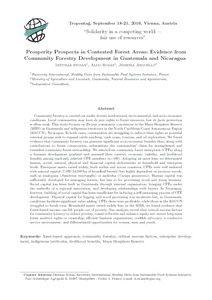Resource information
Tropentag, September 18-21, 2016, Vienna, Austria
“Solidarity in a competing world —
fair use of resources”
Prosperity Prospects in Contested Forest Areas: Evidence from
Community Forestry Development in Guatemala and Nicaragua
Dietmar Stoian
1
, Aldo Rodas
2
, Jessenia Arguello
3
1
Bioversity International, Healthy Diets from Sustainable Food Systems Initiative, France
2
Ministry of Agriculture and Livestock, Guatemala, Natural Resources and Agrotourism,
3
Independent Consultant,
Abstract
Community forestry is carried out under diverse institutional, environmental, and socio-economic
conditions. Local communities may have
de jure
rights to forest resources, but
de facto
protection
is often weak. This study focuses on 25-year community concessions in the Maya Biosphere Reserve
(MBR) in Guatemala and indigenous territories in the North Caribbean Coast Autonomous Region
(RACCN), Nicaragua. In both cases, communities are struggling to enforce their rights as powerful
external groups seek to expand cattle ranching, cash crops, tourism, and oil exploration. We found
evidence that community forestry can generate significant socio-economic benefits that, along with
contributions to forest conservation, substantiate the communities’ claim for strengthened and
extended community forest stewardship. We selected six community forest enterprises (CFEs) along
a business development gradient and assessed their context, economic viability, and livelihood
benefits among randomly selected CFE members (n=180). Adopting an asset lens, we determined
human, social, natural, physical and financial capital endowments at household and enterprise
levels. Enterprise assets varied widely, both within and across countries. CFEs were well endowed
with natural capital (7,000–54,000 ha of broadleaf forests) but highly dependent on precious woods,
such as mahogany (
Swietenia macropylla
) or andiroba (
Carapa guianensis
). Human capital was
sufficiently developed for managing forests, but less so for processing wood and doing business.
Social capital has been built in Guatemala through internal organisation, bringing CFEs under
the umbrella of a regional association, and developing relationships with buyers. In Nicaragua,
however, building of social capital has been insufficient for inducing a self-sustaining process of CFE
development. Physical capital for logging and wood processing was moderate but, in Guatemala,
conditions facilitate significant value adding. CFEs there were profitable, while those in the RACCN
struggled to break even. Household assets varied widely but, in the MBR, we found evidence that
forest-based income can lift people out of poverty. Our analyses reveal that critical success factors
for community forestry to reduce poverty, conserve forests and enhance equity are: secure long-term
forest usufruct rights or ownership, efficient business organisation, credible advocacy, a conducive
service environment, and differentiated opportunities for women, men and youth.


